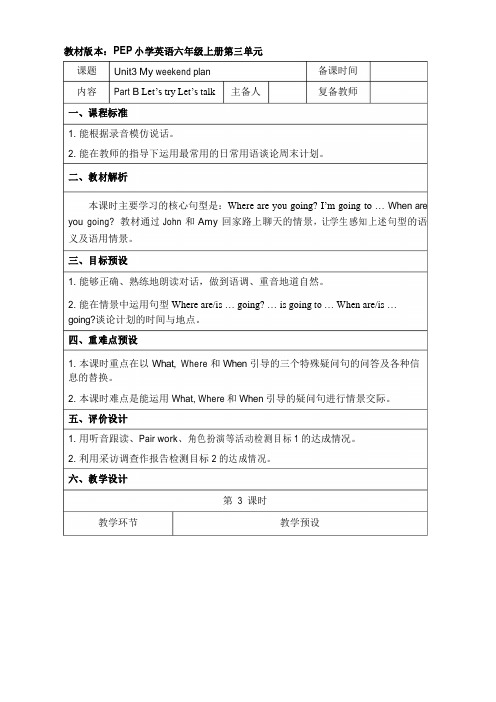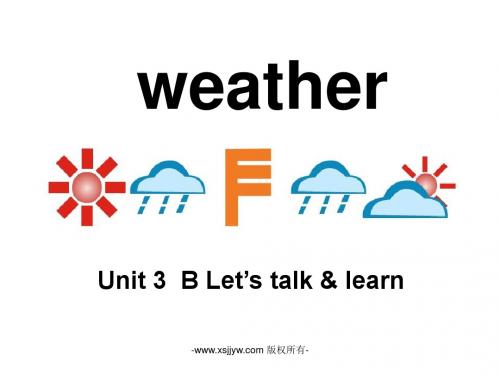Unit3B Learn and talk
人教PEP版四年级英语下册《Unit3 B let’s talk》教学设计教案学案反思

A.Read and answer
a.让学生观察本部分的明信片,师生就明信片上的图开展对话。
让学生阅读明信片上的内容,并根据上下文”理解“love”“fly”,回答明信片上的内容,师生一起核对答”。
B.Look and write
a.让学生观察本部分第一行四线三格内的句子,并请一位学生起来读一读。
让学生观察第一行四线三格内的句子,将第二行四线三格内的句子补充完整,提醒学生在写句子的时候要注意单词在四线三格内的布局以及标点符号。
Step 3:Consolidation and extension
完成“Let’s play”。
a.让学生小组内读一读左边的词卡。
b.教师拿出自己制作的词卡,请一位学生上讲台抽词卡和自己做示范对话。
c.学生同桌合作,用空白卡片制作词卡,抽取词卡进行对话练习,谈论天气。
Step 4:Homework
跟录音读“Let’s learn”这部分的内容。
四上unit3B learn

Unit 3 My friends ?Part B Let ’s learn教学时间:____________ 总第______课时 教学目标:教学目标:能听、说、认读短语long hair, short hair 、brown shoes 、blue glasses 、a green bag 。
能够运用上述短语描述人物的外行特征及衣着打扮。
能够理解不同的句型可以表达相同的意思。
如His glasses are blue.也可以表达为He has blue glasses.教学重点:能听、说、认读短语long hair 、shorthair 、brown shoes 、blue glasses 、a green bag.教学难点:能够理解不同的句型可以表达相同的意思。
如His glasses are blue.也可以表达为He has blue glasses.以及名词复数的使用。
教学准备:点读机、单词卡片、人物及动物图片、一. W arm-up :1、 sing a song: colour song2、 Free talk :talk about your friends. 对照27页let ’splay 。
⒊ 教师出示猴子和兔子的图片,启发学生说:The monkey has along tail,rabbit has a short tail. 教师再出示长颈鹿和梅花鹿的图片,让学生说出:It's tall. It's short.复习单词big, small, long, short, tall, 并说出中文意思。
二.Presentation:1、教师借助自己的头发,说:I have long hair ,教师在找一名男生指着他的头发引出short hair ,教师领读。
然后小组间练习句型,如she has long hair 、short hair 。
2. Look!This is Amy, she is our friend, 教师呈现 Amy 的图片,教师指着 Amy 的鞋子,领读 shoes ,what colour arethey ?brown shoes 。
五年级英语上册Unit3 B Let’ talk 教学反思

五年级英语上册Unit3 B Let’ talk 教学反思我在上五年级第三单元本节课中的任务型教学活动,学习的空间更加开放,能激发学生创造性地使用所学语言,从而使学生的思维得以激活,学生自主学习的能力得以发展。
上课一开始,播放Part B Let’s chant这首歌谣,让学生再次感受这首歌谣的节奏和韵律,为新句型的教学作好铺垫。
接着,事先将Part A Let’learn 中食物图片贴在黑板上(图片上只是图,没有文字提示),教师报其中的图片号码,全体学生抢答。
通过抢答游戏,让全体学生动起来,避免了机械单调地读,活跃了课堂气氛,激发了学生学习的兴趣,同时也锻炼了学生观察、记忆和快速反应的能力,更让学生再次复习单词强化记忆。
在新课教授部分,实行了听力先行,感知新语言.在复习以上单词的基础上,教师布置一个任务,让学生来听一听在以上所有的食物中,教师最喜欢的食物是哪一种?老师自述自己最喜爱的食物和原因。
这样一方面有利于拉近师生之间的关系,另一方面听力练习可以用来帮助学生在进入Let’s talk 新句型的学习之前先从听觉上感知新语言点。
接着,教师在提问一名学生:“What’s your favourite food ?”引出新句型,并引导学生回答。
在此基础上,创设“看看谁的好朋友最多?”游戏。
活动可以如下进行:教师提问一名学生:“What’s your favourite food ?”由学生回答。
如有学生喜欢的食物与他(她)一样,就马上站起来说:“Me too.”然后教师再提问其他学生。
在活动中,教师只要将每次站起来的人数统计好,到活动最后评出好朋友最多的那位学生。
这样的一个活动,把学生带入了真实生活的情境,为练说新句型作好了情感铺垫。
又根据学生的特点,抓住他们喜欢交友、喜欢热闹之情,挖掘学生的认知和情感,也可操练句型“What’s your favourite food?”及其回答,让学生能更好地理解对话。
人教PEP版六年级英语上册《Unit3_B_Let’s_talk名师教案》

教材版本:P EP小学英语六年级上册第三单元课题内容Unit3My weekend planPart B Let’s try Let’s talk主备人备课时间复备教师一、课程标准1. 能根据录音模仿说话。
2. 能在教师的指导下运用最常用的日常用语谈论周末计划。
二、教材解析本课时主要学习的核心句型是:Where are you going?I’m going to…When are you going?教材通过John和Amy回家路上聊天的情景,让学生感知上述句型的语义及语用情景。
三、目标预设1. 能够正确、熟练地朗读对话,做到语调、重音地道自然。
2. 能在情景中运用句型Where are/is … going?… is going to…When are/is…going?谈论计划的时间与地点。
四、重难点预设1. 本课时重点在以What,Where和When引导的三个特殊疑问句的问答及各种信息的替换。
2. 本课时难点是能运用What,Where和When引导的疑问句进行情景交际。
五、评价设计1. 用听音跟读、Pair work、角色扮演等活动检测目标1的达成情况。
2. 利用采访调查作报告检测目标2的达成情况。
六、教学设计第3课时教学环节教学预设一、热身/复习(Warm-up/Revision)二、呈现新课(Presentation)1. 多媒体课件播放本单元歌曲What are you going to do?师生齐唱。
2. Free talkT:What are you going to do?S1: I’m going to… What are you going to do?S2: I’m going to…W hat are you going to do?S3: I’m going to… What are you going to do?…以开火车的形式问答,练习be going to句型。
unit3b_let's_talk_and_learn

Unit 3 B Let’s talk & learn
版权所有-
New York
What’s the weather like in New York?
It’s rainy.
版权所有-
London
What’s the weather like in London? It’s rainy.
(15℃)
(30℃) (-5℃)
(15℃)
(20℃)
Group work:
和你的组员一起说说这 五个地方的天气吧!
版权所有-
It’s
degrees.
cold 5℃
warm 26℃
It’s
in
.
cool 15℃
hot 30℃
版权所有-
world weather
?
New York
版权所有-
world weather
4℃ New York 1℃
? How about Beijing?
Is it cold?
10℃
Yes, it is . No, it isn’t.
30℃
版权所有-
版权所有-
No, it isn’t. It’s cloudy.
版权所有-
Here’s the the world world (世界) Here’s weather. weather. Today It’s ____ it’s hot and and sunny ____ in in Sydney. ____.
版权所有-
It’s cool and rainy. 版权所有-
Moscow
What’s the weather like in Moscow? It’s snowy. It’s cold and snowy.
PEP小学英语四年级上册Unit3 B Let’s talk

PEP小学英语四年级上册Unit3 B Let’s talk一、学情分析:四年级的学生注意不稳定、不持久,难于长时间地注意同一件事物,容易为一些新奇刺激的事物所吸引。
这个年龄段的孩子的有意识记逐渐占据主导地位,从机械识记向意义识记发展。
此阶段的学生开始从具体形象思维向抽象逻辑思维过渡,但是他们的抽象逻辑思维在很大程度上仍然是直接与感性经验相联系,仍有很大的不自觉性和具体形象性。
二、教材分析在学习本课前,学生在三年级下册已接触过描写动物外貌特征的语言It’s has ….本课时是PEP小学英语四年级下册第三单元中第4课时的内容(PEP BOOK 3 Unit 3 Part B Let’s talk )。
对话通过一个模拟真实的情景会话,教会学生如何学会描述人物的外貌特征。
三、整体设计思路本课时是PEP小学英语第三册第三单元第四课时。
教学内容是Unit3 My friends Part B Let’s talk,主要通过学习主要目标语言He has …and his …,教的基础上理解文本,并通过知识的学习,实现在模拟真实的情境下运用目标语言对人物的外貌特征进行描述。
本课的第一阶段是通过Part A Let’s chant,引出本课时的情景“Doraemon ’s friends” ,从整体入手带领学生学习文本,逐渐显露目标语言,并引领学生描述Doraemon朋友的外貌特征;第二阶段,是在为学生提供语言支架的情况下,半放手地让学生根据所学目标语言描述人物的特征;第三阶段,教师给学生提供场景,放手让学生描述身边朋友的外貌特征。
四、教学目标1. About knowledge:1) 能在语境中理解新词hair , glasses , shoes , or , right.2) 能在语境中运用句型He / She has ….and his / her …描述人物的外貌特征。
3) 能理解Let’s talk 对话大意,能用正确的语音语调朗读对话。
人教版六年级下册英语第三单元b部分let's talk

人教版六年级下册英语第三单元b部分let's talkSure, let's get started:In Unit 3 of the sixth grade English textbook by the People's Education Press, students are encouraged to engage in conversational exercises to enhance their language skills. Let's delve into Part B of this unit, which focuses on practicing conversational English in various situations.---。
Imagine a typical day at school. You walk into the classroom, greet your friends, and settle down at your desk. Suddenly, your teacher announces an exciting activity: it's time for a conversation practice session! Your heart races with anticipation as you prepare to engage in lively discussions with your classmates.The first scenario involves planning a party. You and your classmates take turns expressing your ideas for the party, discussing themes, activities, and snacks. You eagerly contribute your thoughts, suggesting games like musical chairs and pin the tail on the donkey. Your classmates nod in agreement, adding their own creative ideas to the mix. Together, you brainstorm a fantastic party plan that promises fun and excitement for everyone.Next, the conversation shifts to discussing weekend plans. You listen intently as your classmates share their upcoming activities, from family outings to sports tournaments. When it's your turn, you confidently describe your plan to visit the local zoo with your family. You paint a vivid picture of seeing exotic animals up close and enjoying a picnic in the park. Your classmates respond with enthusiasm, sharing their own experiences and offering suggestions for places to visit.As the conversation continues, you find yourself immersed in discussions about favorite hobbies, dream vacations, and memorable experiences. You listen attentively to your classmates' stories, eager to learn more about their interests and aspirations. You also take the opportunity to share your own hobbies, recounting thrilling adventures and cherished moments.Throughout the conversation practice session, you actively participate, using a variety of vocabulary and expressions to express your thoughts and feelings. You ask questions, offer opinions, and engage in friendly banter with your classmates. With each exchange, your confidence grows, and your English skills improve.As the session draws to a close, you reflect on the valuable experience of practicing conversational English. You realize that by engaging in meaningful discussions, you not only improve your language abilities but also develop important communication skills. You feel inspired to continue practicing and exploring the world of English language, knowing that each conversation brings you one step closer to fluency.---。
Unit3 My weekend plan B let's talk and learn

price then! John: Really? Thank you!
Why not...?=Why don’t you...? (为什么不......?) Why not+动词原形
Where
My
weekend
see animals
Who my frIienndstroduceplanyour plan
What
Next Sunday When
Try to guess John is on his way home. He sees Amy. What are they going to do?
词典
I am going to buy a dictionary.
单词书
I am going to buy a dictionary.
Read in groups
小组合作,拼读单词, 然后自由对话。
I help you?
What are you going to buy?
I’m going to buy...
My ______ is going to visit me_________. We are going to_____________________. We _______________________________. We will go there_____________________. Because____________________________. ___________________________________
- 1、下载文档前请自行甄别文档内容的完整性,平台不提供额外的编辑、内容补充、找答案等附加服务。
- 2、"仅部分预览"的文档,不可在线预览部分如存在完整性等问题,可反馈申请退款(可完整预览的文档不适用该条件!)。
- 3、如文档侵犯您的权益,请联系客服反馈,我们会尽快为您处理(人工客服工作时间:9:00-18:30)。
big ____ ears
small ____ ears
small ____ head
short ____ long arms
short long tail ____
short long ____ body
big head ____
small big eyes ____
Look at the elephant.
:It has a short tail.
:It has small eyes and big ears.
:Come here ,children! Look at the elephant.
:Wow! It has a long nose.
:It has a short tail.
:It has small eyes and big ears.
big eyes
It has big eyes.
Look at the panda.
a ng body.
Look at the mouse.
a long tail
绿色圃中小学教育网
It has a long tail.
Look at the rabbit.
a short tail
绿色圃中小学教育网
It has a short tail.
:Come here ,children ! Look at the elephant.
:Wow! It has a long nose.
在动物园
big 大的
small 小的
long 长的
short短的
short
短的
big 大的 long
tail 尾巴
small
小的
长的
Bomb Game
small long tall big short tail a big body
Play a game--Bomb
short
Question(问题):
It has a small head. It has a short tail.
tail 尾巴
除此以外,你还能说说这只鸟的其它特征吗?
It has a body.
tail 尾巴
It has
legs.
1.跟读P28页的课文5遍,然后 读给爸爸妈妈听。 2.抄写新学的5个单词,每个1 行,一行5个,边读边写,注意 格式。
It has a long nose.
它有一个长鼻子。
Look at the dog.
a long body
绿色圃中小学教育网
It has a long body.
Look at the fish.
绿色圃中小学教育网
long a short tail
big small
a small head tall
3.He has a smallhead.
1.It has short legs.
绿色圃中小学教育网
2.It’s has a long tail.
4.He has a big head.
